To read a full report, please download PDF
Geopolitical risk aversion may dominate
FX View:
The flare up in geopolitical risk from the Middle East has had a relatively muted impact so far on financial markets. The CHF has been the main beneficiary amongst G10 currencies. It has also helped to knock US yields of their recent peak and contributed a modest reversal of USD strength. The other key factor that helped to dampen upward pressure on the USD and US yields has been the change in rhetoric from Fed officials who have indicated that higher market yields if sustained will reduce the need for a final rate hike this year. Without those comments the USD would have been stronger after the recent upside surprises for the September NFP and CPI reports. The ongoing strength of the US economy suggests that the setback for the USD will prove short-lived. Market participants will be watching closely in the week ahead to see if China’s economy is deriving more support from policy stimulus when the latest GDP report for Q3 will be released.
CHF OUTPERFORMS ON HEIGHTENED GEOPOLITICAL RISKS
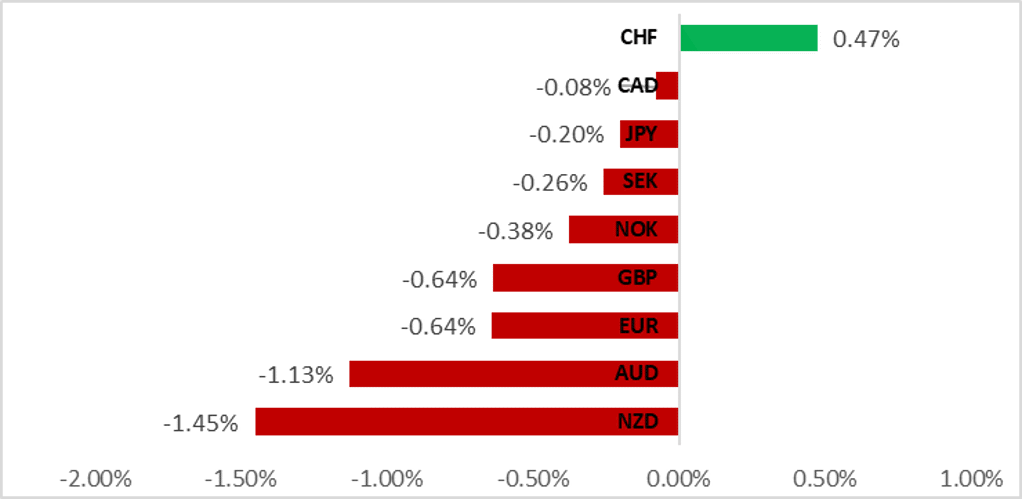
Source: Bloomberg, 13:00 BST, 13th October 2023 (Weekly % Change vs. USD)
Trade Ideas:
We are recommending a new long AUD/NZD trade idea, and closing our long USD/ZAR trade idea after the stop-loss was hit.
JPY Flows:
We look at the high frequency Japan flow data this week and the weekly data from the MoF released today revealed modest foreign bond buying by Japanese investors while foreign investors returned to the Japan equity market after some heavy selling in recent weeks. IMM positioning data also revealed some increased appetite for selling the yen by Leveraged Funds.
FOMC Minutes Sentiment Analysis:
The latest FOMC minutes released earlier this week highlights a Fed optimistic to the potential of a soft landing yet cautious to upside/downside risks to inflation. This supports our house view that the Fed will leave rates on hold for the rest of the year. Our aggregated sentiment analysis indicator has risen to levels not seen since May-2022.
FX Views
USD: The setback for the USD should prove short-lived
The USD has suffered a setback in recent weeks after the dollar index place peaked at 107.35 on 3rd October. While the scale of the setback has been relatively modest, the dollar index did decline for six consecutive days from 3rd to 10th October and hit a low yesterday at 105.54. It is the largest sell-off for the USD since the 1H of July. Recent price action highlights that the USD is starting to lose upward momentum after the relentless rally recorded between 2H July and September. After failing to hold on to initial gains following last week’s much stronger NFP report for September, the USD has continued to correct lower for most of this week undermined by the pullback in US yields. The 10-year UST yield peaked out just after last week’s NFP report hitting a new cyclical high at 4.89% and has since fallen back to a low yesterday of 4.52%. The move lower in US yields and the USD was initially triggered at the start of this week by heightened geopolitical tensions in the Middle East relating to the Hamas and Israel conflict that put a bid into the government bond and oil markets. However, the financial market impact so far from the conflict has been relatively muted. The price of oil initially rose by around USD6/barrel. The main beneficiary in the FX market this week from the pick-up in geopolitical risks has been the Swiss franc which has been the top performing G10 currency.
The correction lower for US rates and the USD has also been driven by the clear shift in rhetoric from Fed officials since last week. There appears to have been a coordinated attempt by Fed officials to signal more concern over the sharp move higher in US yields which has contributed to a significant tightening in US financial conditions that is equivalent to one or two 25bps rate hikes by the Fed. If market yields remain at higher levels, Fed officials have signalled that they are less likely to follow through with plans to hike rates one final time this year. The comments have helped to dampen upward pressure on US yields from strong US growth and the release yesterday of the unfavourable US CPI report for September. The most recent growth forecasts uploaded to Bloomberg for US GDP in Q3 have averaged 3.5% although they then expect growth to slow back to an average of 1.1% in Q4. If growth remains stronger than expected and inflation fails to slow further, then one final Fed hike still can’t be ruled out. In light of these developments, market participants will be listening closely to comments from New York Fed President Williams (Tuesday) and Fed Chair Powell (Thursday) who are both scheduled to speak at the Economic Club of New York.
In these circumstances, we expect the USD to consolidate close to recent highs in the coming weeks. The ongoing run of strong US economic data continues to pose upside risks for the USD and US yields even as Fed rhetoric is acting as a dampener.
US YIELDS ADJUST TO PRICE IN HIGHER RISK PREMIUM
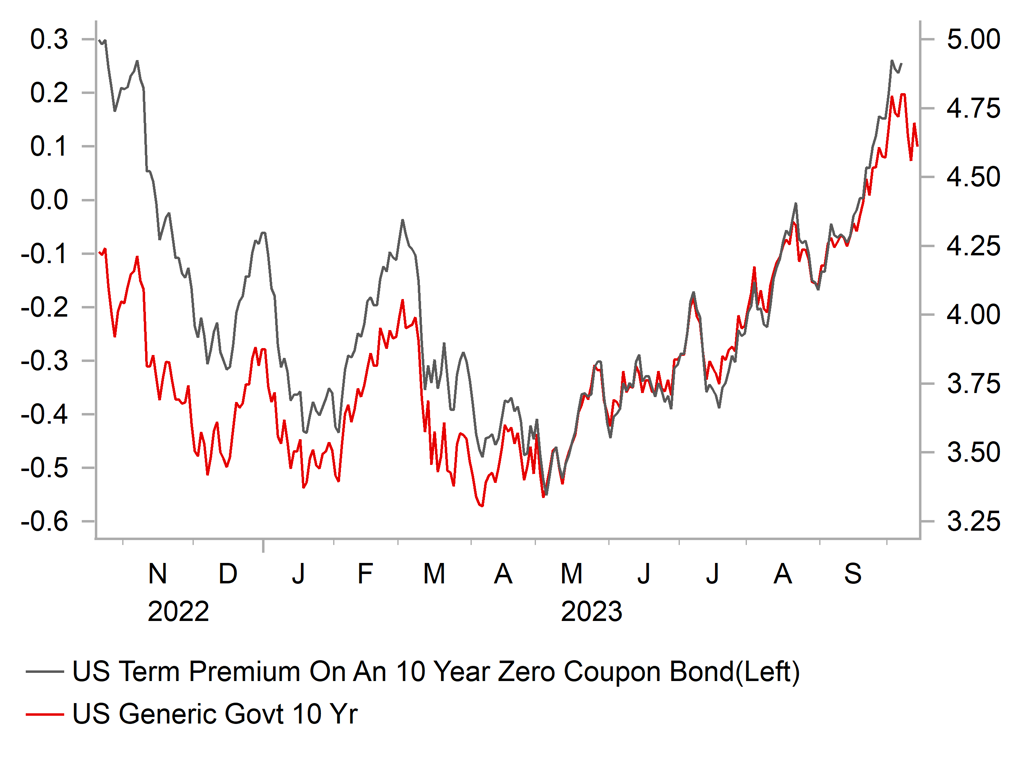
Source: Bloomberg, Macrobond & MUFG GMR
USD’S RELATIONSHIP TO OIL PRICE HAS CHANGED
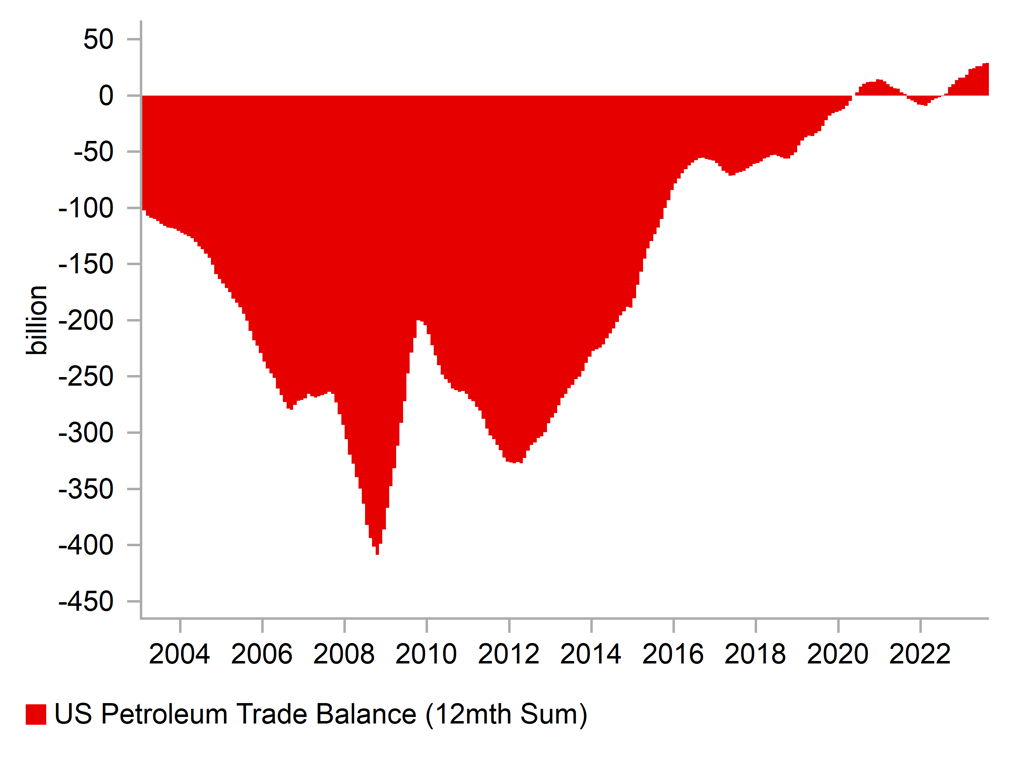
Source: Bloomberg, Macrobond & MUFG GMR
CNY: Stabilising growth will help reduce USD/CNY upside risks
Both onshore and offshore RMB are trading above the 7.3000-level again versus the US dollar and hence are approaching the limit to recent acceptance levels for the Chinese authorities. The PBoC continues to set daily fixings well below the consensus estimate and spot. Today, the PBoC fixing was nearly 14 big figures below the Bloomberg consensus. The PBoC today in a press briefing explained the current USD/CNY level as down to broader US dollar strength and a “boom in forex purchases”. The PBoC emphasised again its policy of FX stability and described the movements in RMB CFETS Index as “basically stable”. The RMB CFETS index is now actually 4.4% stronger from the most recent low-point in July and is back close to the 100-level than prevailed through the first four months of 2023 when USD/CNY was trading between 6.7000-6.9000, highlighting the impact of effectively capping USD/CNY at 7.3000 in circumstances of broader US dollar strength.
We still see risks of broader US strength over the short-term and hence in that regard upward pressure on USD/CNY may well persist. However, there are signs that the policy steps taken over the summer could be helping to bring about some stability and may in turn help improve sentiment that limits the upside USD/CNY pressure. Trade data today revealed a further improvement in exports with the annual rate of decline slowing from -8.8% to -6.2%. Loans data revealed that Aggregate Financing increased by more than expected, from CNY 3,124bn to CNY 4,120bn. Household sentiment may be improving. Loans to households, mainly mortgages, increased CNY 544bn in September, the largest increase since March and likely a direct consequence of cuts to mortgage rates and the easing of rules in regard to mortgage lending.
The reports this week that the Chinese authorities are finalising plans to loosen fiscal policy will likely prove a very important shift in stance if proved correct. The indebtedness at the local government level and the sharp drop in revenues from the sale of land as the property market slows could get a meaningful measure of support through additional fiscal expansion. Reports suggest an increase in government bonds totalling CNY 1 trillion to finance infrastructure spending resulting in the deficit-to-GDP going well over the 3% limit set in March. The authorities see the risks stemming from weak demand given current near deflationary conditions and are set to continue with more direct policy support. This is fuelling a narrowing of local-government financing vehicles bond yields over sovereign yields with the 1-year AA-rated LGFV bond spread falling below 150bps for the first time since 2020. The yield on the 1-year LGFV bonds has fallen by over 100bps from the peak while central government bond yields have been increasing given the news of an additional CNY 1 trillion of stimulus. Clearly the
PBOC RRR BACK TO LEVELS NOT SEEN SINCE 2007
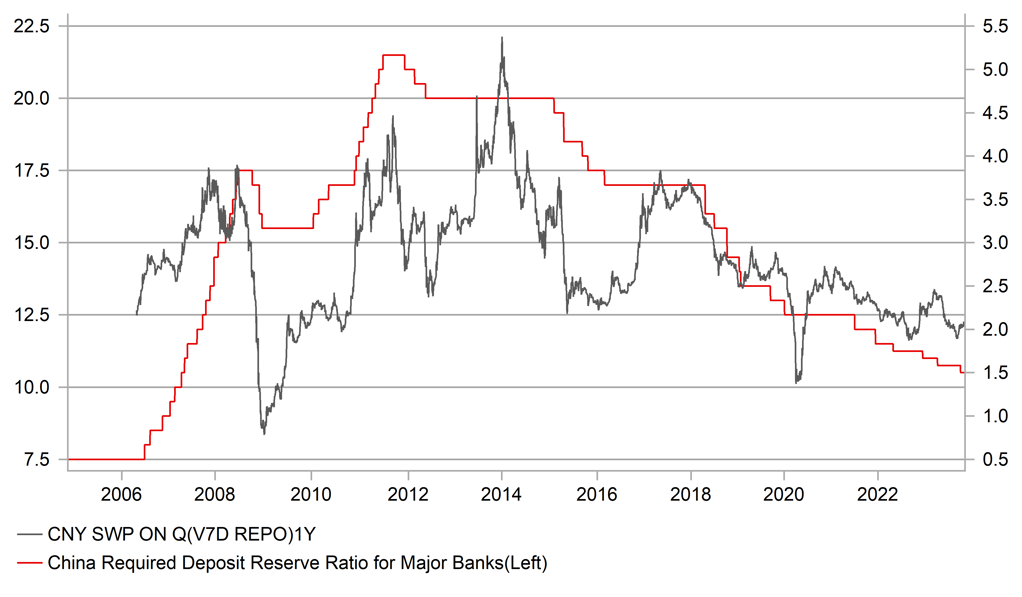
Source: Bloomberg, Macrobond & MUFG GMR
CHINA’S NET FDI OUTFLOW HIT A RECORD IN Q2 2023
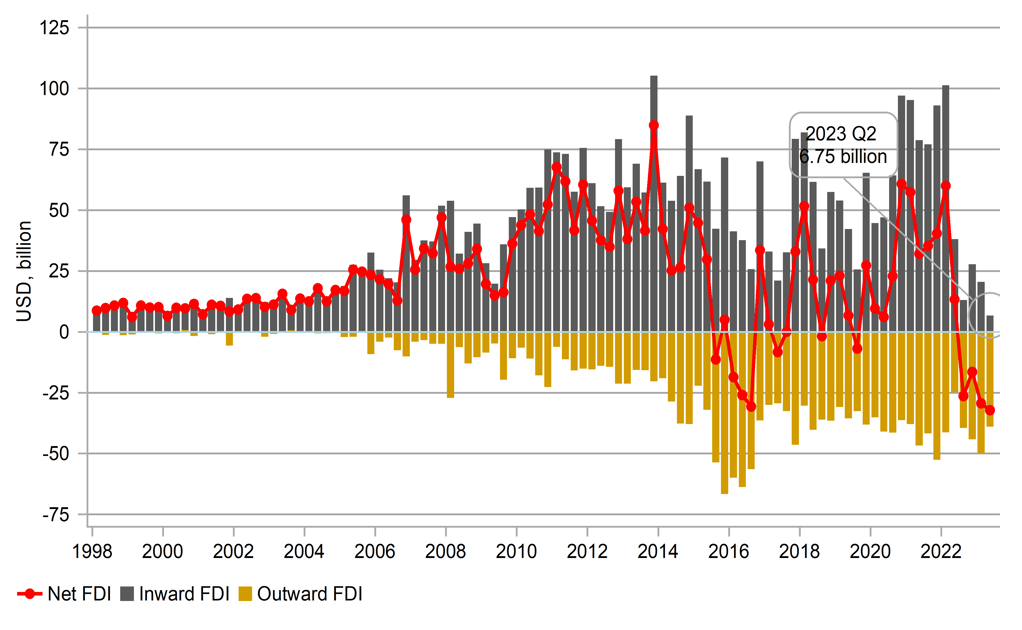
Source: Bloomberg, Macrobond & MUFG GMR
government’s attempts through policy steps has improved investor sentiment. On the demand side, there has been a surge in demand with investor orders for new LGFV notes maturing in less than one year exceeding supply by a record 4.6 times in August after the government first started to implement supportive policies. The PBoC cut its main policy rate by 15bps in August and then the PBoC cut the RRR by 25bps on 15th September. Mortgage rates are coming down and today the PBoC confirmed that rates on CNY 21.7trn worth of mortgages saw rates come down between 25th Sept and 1st Oct. Reports today also suggest that the authorities are looking to set up a stock market stabilisation fund to help restore confidence amongst domestic investors.
These policy measures and the potential for more before year-end should help to ease capital outflows from China. The current data available does suggest sustained portfolio outflows on both the bond and equity side. Bond Connect data shows CNY 290bn (USD 41bn @ 12mth avg USD/CNY) worth of bond sales to June. Equity sales by foreign investors totalled USD 69bn in the 12mths to June according to Bloomberg data. That takes total portfolio outflows to USD 110bn. The actual figure may well be more than the officially available data but when this is then added to the net FDI outflow figure (USD 105bn) we get to a total net FDI portfolio outflow total of USD 215bn. Of course avenues for China investor outflows means the total net outflow is larger. In any case, it is important to remember that China’s current account surplus covering the same 12mth period is considerably larger. Over the four quarters to June, China’s current account surplus totalled USD 389bn, much of that China’s merchandise trade surplus. The hoarding of FX by Chinese corporations is certainly likely a part of the current upward pressure on USD/CNY.
Assuming our broader USD views play out, we would expect to see continued upside risks for USD/CNY over the coming two months or so but by the end of the year, the dollar will be trading similar levels to now. We then see notable USD depreciation in H1 next year. If China stimulus persists and the data turns more favourable the upside USD risks will be offset and indeed could more than offset those risks by year-end. We currently forecast USD/CNY at 7.1500 at year-end and then breaking below the 7.000 level in H1 next year. China’s current account surplus and available source of the US dollar we believe will help China to continue promoting USD/CNY “stability”£ by ensuring no major breach higher from current levels. Recent policy actions will only help achieve that FX stability. The main risk scenario relates to a more pronounced short-term further gain for the dollar. With the RMB CEFTS already 4.4% higher since July, the authorities may be forced to accept an increase in USD/CNY in order to diminish the gain on an RMB CFETS basis.
NEAR SUSTAINED BOND OUTFLOWS SINCE FEB 2022
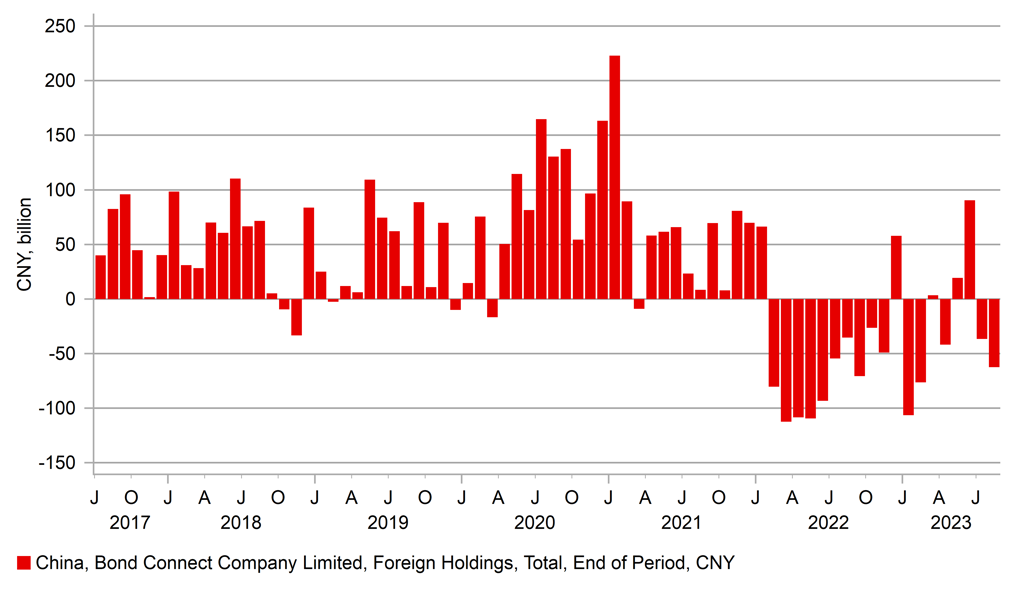
Source: Bloomberg, Macrobond & MUFG
NEAR SUSTAINED BOND OUTFLOWS SINCE FEB 2022
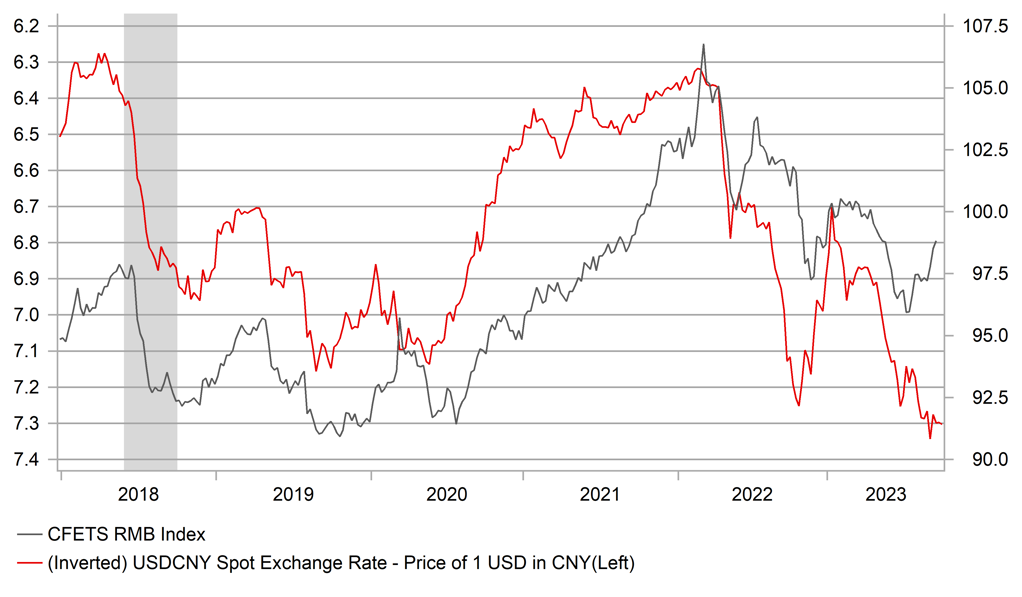
Source: Bloomberg, Macrobond & MUFG
Weekly Calendar
|
Ccy |
Date |
BST |
Indicator/Event |
Period |
Consensus |
Previous |
Mkt Moving |
|
NZD |
10/14/2023 |
Tbc |
New Zealand Election |
!!! |
|||
|
CNY |
10/16/2023 |
02:20 |
1-Yr Medium-Term Lending Facility Rate |
2.5% |
2.5% |
!! |
|
|
JPY |
10/16/2023 |
05:30 |
Industrial Production MoM |
Aug F |
-- |
0.0% |
!! |
|
EUR |
10/16/2023 |
Tbc |
Euro-Area Finance Ministers Meet |
!! |
|||
|
GBP |
10/16/2023 |
09:30 |
BoE's Pill speaks |
!!! |
|||
|
NZD |
10/16/2023 |
22:45 |
CPI YoY |
3Q |
5.8% |
6.0% |
!!! |
|
AUD |
10/17/2023 |
01:30 |
RBA Minutes of Oct. Policy Meeting |
!! |
|||
|
GBP |
10/17/2023 |
07:00 |
Average Weekly Earnings 3M/YoY |
Aug |
-- |
8.5% |
!!! |
|
GBP |
10/17/2023 |
07:00 |
Employment Change 3M/3M |
Aug |
-- |
-207k |
!!! |
|
EUR |
10/17/2023 |
10:00 |
Germany ZEW Survey Expectations |
Oct |
-- |
-11.4 |
!! |
|
USD |
10/17/2023 |
13:00 |
Fed's Williams speaks |
!!! |
|||
|
USD |
10/17/2023 |
13:30 |
Retail Sales Advance MoM |
Sep |
0.3% |
0.6% |
!!! |
|
CAD |
10/17/2023 |
13:30 |
CPI YoY |
Sep |
-- |
4.0% |
!!! |
|
USD |
10/17/2023 |
14:15 |
Industrial Production MoM |
Sep |
-0.1% |
0.4% |
!! |
|
CNY |
10/18/2023 |
03:00 |
GDP SA QoQ |
3Q |
1.0% |
0.8% |
!!! |
|
CNY |
10/18/2023 |
03:00 |
Industrial Production YoY |
Sep |
4.3% |
4.5% |
!! |
|
CNY |
10/18/2023 |
03:00 |
Retail Sales YoY |
Sep |
4.8% |
4.6% |
!! |
|
GBP |
10/18/2023 |
07:00 |
CPI YoY |
Sep |
-- |
6.7% |
!!! |
|
EUR |
10/18/2023 |
10:00 |
CPI YoY |
Sep F |
-- |
4.3% |
!! |
|
USD |
10/18/2023 |
19:00 |
Federal Reserve Releases Beige Book |
!! |
|||
|
JPY |
10/19/2023 |
00:50 |
Trade Balance |
Sep |
-¥507.8b |
-¥930.5b |
!! |
|
AUD |
10/19/2023 |
01:30 |
Employment Change |
Sep |
21.5k |
64.9k |
!!! |
|
USD |
10/19/2023 |
13:30 |
Initial Jobless Claims |
Oct-14 |
-- |
-- |
!! |
|
USD |
10/19/2023 |
17:00 |
Fed's Powell speaks |
!!! |
|||
|
JPY |
10/20/2023 |
00:30 |
Natl CPI YoY |
Sep |
3.0% |
3.2% |
!!! |
|
GBP |
10/20/2023 |
07:00 |
Retail Sales Inc Auto Fuel MoM |
Sep |
-- |
0.4% |
!! |
|
GBP |
10/20/2023 |
07:00 |
Public Sector Net Borrowing |
Sep |
-- |
10.8b |
!! |
|
CAD |
10/20/2023 |
13:30 |
Retail Sales MoM |
Aug |
-- |
0.3% |
!! |
Source: Bloomberg, Macrobond & MUFG GMR
Key Events:
- The speeches from Fed Chair Powell (Thursday) and New York Fed President Williams (Tuesday) will garner more market attention in the week ahead. New York President Williams and Fed Chair Powell will both be speaking at the Economic Club of New York. In light of recent comments from other Fed officials, market participants will be watching closely to see if the leadership at the Fed share the same view that higher market rates if sustained will reduce the need for one final hike this year.
- The final opinion polls are signaling that the main opposition National Party are expected to win the election in New Zealand over the weekend. They are expected to form a majority government with support from the libertarian ACT Party and nationalist New Zealand First Party.
- The release of the latest month activity data from China for the month of September will be watched closely to see if stimulus measures are helping to support economic growth heading into year end. For Q3 as whole the quarterly pace of economic growth is expected to pick-up modestly to 1.0% in Q3 up from 0.8% in Q2. Stronger activity in September would reinforce confidence that upward momentum can be sustained in the final quarter of this year as well.
- The main inflation updates in the week ahead will be from Canada and Japan. The BoC have signaled concern recently that core inflation is proving more persistent than desired. After picking up in August, another stronger reading in September will encourage speculation over another 25bps hike from the BoC this year. There has also been speculation that the BoJ is moving closer to tightening policy through raising rates at the start of next year as it becomes more confident in the sustainability of higher inflation. The release of the latest CPI report for September will provide more insight into the persistence of higher inflation in Japan.
- In the UK the latest CPI (Wednesday) and labour market (Tuesday) reports will be released. Further evidence of slowing inflation alongside a peaking out of wage growth would reinforce expectations for the BoE keep rates on hold.



